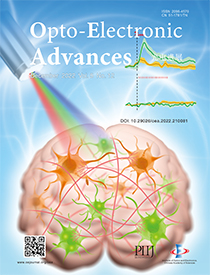2022 Vol. 5, No. 12
Cover story: Wang SL, Shan YD, Zheng DH, Liu SG, Bo F et al. The real-time dynamic holographic display of LN:Bi,Mg crystals and defect-related electron mobility. Opto-Electron Adv 5, 210135 (2022).
Real immersion experience makes three-dimensional (3D) display a huge market demand. The dreamed 3D display in future should be viewed without auxiliary wearable devices. Holographic 3D display has been regarded as an ultimate technique that does not need visual aid and can bring people an unprecedented sense of presence. However, the realization of holographic 3D display faces many difficulties and challenges, especially the lack of refreshable holographic materials. Recently, Professor Yongfa Kong and Professor Jingjun Xu at MOE Key Laboratory of Weak-Light Nonlinear Photonics in Nankai University reported a bismuth and magnesium co-doped lithium niobate (LN:Bi,Mg) crystal, in which the photorefractive response time is shortened to 7.2 ms and a sensitivity as high as 646 cm/J. This crystal was used to demonstrate a real-time holographic display at a refresh rate of 60 Hz, as that of high-definition television. In addition, the first-principles calculations indicate that the electron mobility while Bi ions occupying Nb-sites is significantly larger than that in Li-sites, which directly induces the fast response of LN:Bi,Mg crystals when the concentration of Mg is above its doping threshold. This research provides an ideal candidate material for holographic 3D display and expands the technique for performance control of LN crystals.
Cover story: Qi ZY, Guo QC, Wang S, Jia MY, Gao XW et al. All-fiber-transmission photometry for simultaneous optogenetic stimulation and multi-color neuronal activity recording. Opto-Electron Adv 5, 210081 (2022).
Optogenetics and optical detection methods can manipulate and monitor cell-type-specific neuronal activity in behaving animals with specific excitation light. However, they are mostly separated and work independently, and it is quite challenging to combine multi-color recording with optogenetics and to completely filter out optogenetic stimulation light with milliwatt. Obvious artifacts from optogenetic stimulation are inevitable in a weak (pico watt) fluorescent signal during recording. Recently, Prof. Ling Fu group in Huazhong University of Science and Technology and Prof. Minmin Luo group in Chinese Institute for Brain Research reported an all-fiber-transmission photometry system for simultaneous optogenetic and multi-color recording of neuronal activities and the neurotransmitter release in freely moving animals. They firstly demonstrate successful dual-color recording of neuronal Ca2+ signals and dopamine dynamics in the NAc upon delivering an unexpected reward and the simultaneous optogenetic input from the upstream ventral tegmental region. Using a custom-designed multi-branch fiber bundle, this system can conveniently deliver all of the required light using optical fibers, making the system more robust for use in freely behaving experimental contexts and dual-color recording. This all-fiber-transmission recording and manipulation system can not only record the activities of multiple types of neurons or neurotransmitters simultaneously, but also manipulate neuronal activities in real-time in combination with optogenetics. These combined capacities make our system valuable for causal investigations in neural circuits and the study of brain diseases.

-
{{article.year}}, {{article.volume}}({{article.issue}}): {{article.fpage | processPage:article.lpage:6}}. doi: {{article.doi}}{{article.articleStateNameEn}}, Published online {{article.preferredDate | date:'dd MMMM yyyy'}}, doi: {{article.doi}}{{article.articleStateNameEn}}, Accepted Date {{article.acceptedDate | date:'dd MMMM yyyy'}}CSTR: {{article.cstr}}
-
{{article.year}}, {{article.volume}}({{article.issue}}): {{article.fpage | processPage:article.lpage:6}}. doi: {{article.doi}}{{article.articleStateNameEn}}, Published online {{article.preferredDate | date:'dd MMMM yyyy'}}, doi: {{article.doi}}{{article.articleStateNameEn}}, Accepted Date {{article.acceptedDate | date:'dd MMMM yyyy'}}CSTR: {{article.cstr}}

 E-mail Alert
E-mail Alert RSS
RSS



